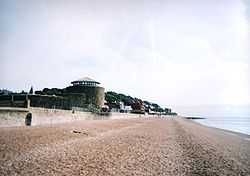Sandgate Castle

Sandgate Castle is a coastal castle at Sandgate near Folkestone in Kent. It was originally built as an artillery castle in 1539–1540 by Henry VIII of England as part of his chain of coastal defences in response to the threat of invasion. As these forts were devised by Henry VIII, they are known as Device Forts. It was built to defend a vulnerable stretch of coastline and due to its proximity to the French coast the site has been constantly defended and refortified.
Construction 1539–1540
The original castle, started in 1539, is one of the most comprehensively documented of its time and the record still exists in the British Library. The total cost of the build was some £5,584.7s.2d.[1] The construction took 18 months and the accounts were closed on 2 October 1540. The comptroller for the build period, Thomas Cocks, was paid the grand sum of £50 and the build employed around 500 people using 147,000 bricks, 44,000 tiles at 4s per thousand, a thousand cartloads of oak, 9.5 tons of lead and 4.5 tons of iron. 16d per day was paid for carts to haul stone and materials. Richard Lynsted was master mason. Sandgate's construction was supervised by Stefan von Haschenperg, who signed the accounts, though he was not often present. Haschenperg disagreed with other officials over the roofing materials. He preferred tar and pitch rather than less flammable lead, and this was a feature of his other building at Camber Castle.[2]
The original castle comprised a large, three-storey central keep surrounded by two concentric curtain walls. The inner curtain wall had three smaller, round towers and the outer curtain wall had a three-storey gatehouse to the north (still in almost its original form) and a rectangular building or barbican connecting it to the central keep. All of the buildings were originally roofed and the castle was designed so that it rose progressively from the outside in to provide up to four tiers of heavy guns. These were positioned behind 65 embrasures or gun ports and there were also gun loops in the lower levels of the towers and buildings to provide flanking fire.
Sandgate’s sister castles were Sandown Castle, Kent, Walmer Castle and Camber Castle, in Kent and Sussex respectively. Sandown no longer exists, it was taken by the sea some years ago and Camber Castle is derelict. Walmer Castle, however, remains in the ownership of English Heritage and is the home of the Warden of the Cinque Ports.
Subsequent history

During the castle’s long history Henry VIII visited in 1542, Elizabeth I in 1572 and 1588 and Queen Victoria and Prince Albert in the late 1800s. In 1715–1716 the keep was re-roofed and the seaward battery rebuilt following damage by the spring tides. In 1805–1806, during the Napoleonic wars, a major series of alterations were carried out on the castle to convert it into a gun fort/castle. The tops of the original defensive towers were removed and the central tower converted into a Martello-style tower mounting a coastal battery.
In the late 1850s a new magazine was built and alterations made to the existing gun emplacements. Pillboxes were constructed at the castle during the 2nd World War. Bizarrely by today’s heritage standards, the castle was sold by the government due to defence cutbacks in 1889. From the late 1890s the castle has gone through a number of nonmilitary reincarnations and uses. It became a private house in the late 1890s, but was again requisitioned for defence in both the 1st and 2nd World Wars. The South Eastern Railway Company applied to have the castle demolished in 1911 to provide a rail link along the coastline from Hythe to Folkestone In 1960 another application for demolition and replacement with a block of flats was rejected by the planning authority.
The great storm of 1950 took around a third of the front portion of the castle, and most of the outer wall on the south side was destroyed by coastal erosion. New sea defences were built shortly thereafter to protect it for the future. Consequently the castle title deeds still contain ownership below the low water mark where the castle originally stood.
For a period it became a museum, then a banqueting facility/restaurant and was finally converted into a permanent private dwelling in the late 1990s under the strict supervision of the Department of Environment and English Heritage. By then, the castle’s appearance had changed radically, with most of it re-faced during Napoleonic times, although there is evidence in the curtain walling of the original Tudor stonework, including French stone from Caen brought from the local monasteries of St Radegund near Dover and Christchurch, Canterbury, demolished during the dissolution.[3]
The castle is now in good heart as a private dwelling, and the main keep is topped with a distinctive stainless steel cap.
Further reading
- ↑ British Library Harleian Collection MSS. 1647, 1651; see Letters & Papers Henry VIII, vol. 14 part 2, no. 645 & vol. 16, no. 113.
- ↑ Colvin, Howard, ed., History of the King's Works, (1982), 570, 576-577.
- ↑ Colvin, Howard, ed., HKW, vol. 4 part 2, (1982), 576.
- Colvin, H.M. (ed) (1982). The History of the King's Works, Vol. IV, 1485–1600, Part II.
- Harrington, Peter (2007). The castles of Henry VIII. Oxford: Osprey. ISBN 978-1-84603-130-4
- Harris, E.C., "Archaeological investigations at Sandgate Castle, Kent, 1976–7," Post-Medieval Archaeology, Vol. 14, 1980, pp. 53–88.
- Morley, B. M. (1976). Henry VIII and the development of coastal defence. London: H.M. Stationery Office. ISBN 0-11-670777-1
- Rutton, W. L., 'Sandgate Castle, 1530–40', Archaeologia Cantiana, vol. 20, (1893), pp. 228–257, includes analysis of the building account.
- Rutton, W. L., 'Sandgate Castle', Archaeologia Cantiana, vol. 21, (1895), pp. 228–257, subsequent history to 19th-century.
See also
External links
Coordinates: 51°4′24.4″N 1°8′56″E / 51.073444°N 1.14889°E
| ||||||||||||||